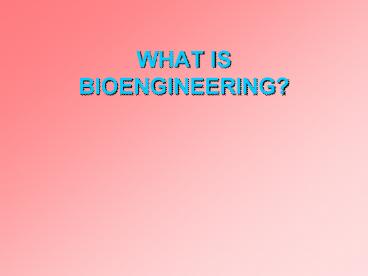WHAT IS BIOENGINEERING? - PowerPoint PPT Presentation
1 / 23
Title:
WHAT IS BIOENGINEERING?
Description:
WHAT IS BIOENGINEERING? Bioengineering is Diverse! Each bioengineer only knows a tiny fraction of the entire field What is Bioengineering? Any Area of Biology Mixed ... – PowerPoint PPT presentation
Number of Views:602
Avg rating:3.0/5.0
Title: WHAT IS BIOENGINEERING?
1
WHAT IS BIOENGINEERING?
2
Bioengineering is Diverse!
- Each bioengineer only knows a tiny fraction of
the entire field
3
What is Bioengineering?
- Any Area of Biology
- Mixed with
- Any Area of Engineering
- In
- Any Proportion
4
Biologists
- Want to understand organisms and living systems
- Discover underlying mechanisms that govern how
organisms work - The knowledge is then used to develop or improve
medical, industrial or agricultural processes. - Comfortable with uncertainty
5
Engineers
- See a problem and want to come up with a
practical solution - Apply mathematics and scientific knowledge
- Want precision and reproducibility
- Consider technical and economic constraints
6
- Bioengineering applies engineering methods and
techniques to problems in biology and medicine.
Biology
Medicine
Engineering
Tissue Engineering Neural Implants DNA Expression
Arrays
Pumps Pacemakers Prosthetics
7
Biomechanics and Rehabilitation
- Artificial limbs
- Replacement joints
- Cochlear implants
- Pacemakers for heartbeat regulation
8
Cochlear Prostheses
http//www.cochlearimplant.com/
9
All imaging and diagnostic techniques
- Help with medical diagnosis
- Assist in research for better cures
- EKG machines
- MRI
- Ultrasound imaging
10
MRI and Functional MRI
UIUC MRI researchers Profs. Sutton (BioE), Liang
(ECE)
11
Ultrasound Imaging and Bioeffects
UIUC Ultrasonics Led by Profs. Insana, OBrien,
Oelze, Frizzell
GE Medical Systems
High resolution ultrasonic imaging of liver with
a microprobe
http//www.gemedicalsystems.com/rad/us/4d/thennow.
html
http//www.brl.uiuc.edu
12
What kind of scientists are involved with
Magnetic Resonance Imaging?
- Electrical Engineers electromagnetics
- Computer Engineers/Scientists computation
- Physiologists biological function
- Chemists new imaging agents
- Psychologists mental function
- Physicians medical implications
13
Cell and Tissue Engineering
- Cell and Tissue Engineering allows us to repair
or replace the function of natural tissue with
bioengineered substitutes. - Principles of engineering, chemistry, and biology
are combined to create tissue substitutes from
living cells and synthetic materials.
Tissue Engineered Skin
New Companies Advanced Tissue Sciences,
Inc. Organogenesis
14
The Potential Promise of Tissue Engineering
- To repair or replace damaged organs
- Origins in the late 1980s
- Rapid advances in stem cell biology
- The tissue engineer needs to
- manipulate,
- produce, and
- deliver
- collections of cells as building blocks of tissues
15
A Wide Spectrum of Knowledge is Required for
Tissue Engineering
- Basic biological sciences
- Cell biology and histology
- Physiology
- Embryology
- Wound healing
- Clinical aspects
- Surgery and transplantation
- Immunology
- Pathology
- radiology
- Biotechnologies
- Cell culture
- Cell separation
- Gene transfer
- Engineering fundamentals
- Fluid dynamics
- Transport phenomena
- Materials science
- Mechanics
- Chemical kinetics
16
Participants in Tissue Engineering
- Bioengineers
- Materials scientists
- Cell and molecular biologists
- Immunologists
- Policy makers and ethicists
- Chemical engineers
- Surgeons
17
Neural Engineering
- Neural Engineers use modeling and analysis to
understand and control the nervous system. - Advances in neuroscience and microfabrication
have opened the doors to exciting applications in
neuroprosthetics, biosensors and hybrid
biocomputers.
Fluorescent Stained Myocyte
Microfabrication Surface
18
Designing Networks of Neurons in a Petri Dish
Input
Output
Ideal Neuronal Networks
Real Networks of Nerve Cells in Culture on
Patterned Substrates
Prof. Wheeler, UIUC Prof. Brewer, SIU Med
School, Springfield
19
Biomimetics
- Mimicking biological systems to create new
technologies
20
Modeling Channels Through Cell Membranes
andProtein / Surface Interactions
Understanding Molecular Structure by Applying
Engineering Principles
Biomolecular Modeling
Computer Image of a DNA Binding Protein
21
Bioinformatics and Genomics
- Bioinformatics computer science biomedicine
- Discover genetic basis for disease (cancer,
diabetes) - Develop new diagnostic devices (cDNA chip)
cDNA Array
22
Genetic Engineering
- Animals
- To produce a high-value therapeutic protein
- Pharm animals
- Plants-GMOs
- Improve plant yields
- Grow plants with higher nutrient value
- Plants with vaccines incorporated
- Pharmaceutical products
- Manipulate cells genetically
- Produce large quantities of vaccine, insulin,
other useful proteins for medicine
23
Bioengineers make use of all of these fields
- Biology
- Medicine
- Materials Science
- Electrical Engineering
- Computer Science
- Computer Engineering
- Physics
- Chemical Engineering
- Mechanical Engineering
- Nuclear Engineering
- Civil Engineering
- Agricultural Engineering































